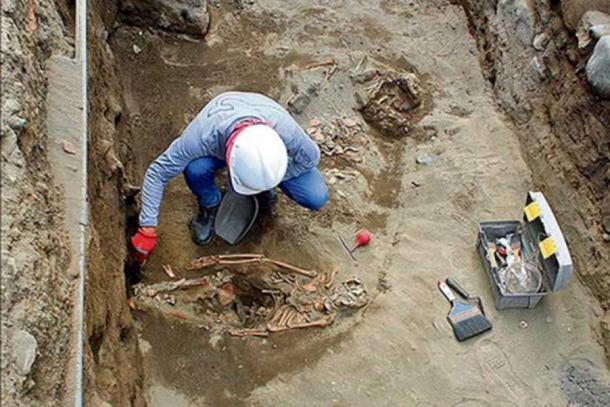Peruvian Pyramid of the Bees Reveals Its Deathly Secrets
The Inca Empire of modern-day Peru dominated the South American Andes mountain range with a vast network of roads, farms and temples, before the Spanish conquest in the 16th century.
Archaeologists at the Tucume archaeological site in Peru have discovered “extensive Incan burials” inside a structure known as the Pyramid of the Bees (Huaca Las Abejas), in a Pacific coast desert valley 400 miles from Lima, the centre of the Inca’s Andean empire. Reuters detailed the discovery of “two dozen cave-like tombs with human remains and pottery.“
Jose Manuel Escudero, director of the archaeological team at the pyramid said "There's a reutilization of the space,” adding “It appears each culture just found that it was convenient to use this site to govern." Detailing their finds, Escuardo told reporters that they discovered the bodies of men “holding spiked spondylus shells,” which were regarded as important ritual objects by various pre-Colombian cultures in Peru.
Elite Burials
A report in the New York Times detailed the discovery of one particular body which was found “laid on ceramic pieces and wrapped carefully” about which Escudero said “It’s wrapped in more than 4 shrouds, one of which is quilted," and "You're not going to bury an ordinary person that way,” telling him this person probably belonged to an elite in society.
- Newly Unearthed Pre-Inca Tombs Show Ancient Chimú Practiced Child Sacrifice
- Mummy Juanita: The Sacrifice of the Inca Ice Maiden
- Analysis Shows Children were Given Drugs and Alcohol before Ritual Sacrifice 500 Years Ago
Child Sacrifice
This discovery further establishes the importance placed in appeasing the gods by adhering to carefully crafted burial rites, which was extremely important to all pre-Colombian Andean cultures. Living in raw, unpredictable outdoor environments they all too often fell victim to floods, droughts and extreme weather which they associated with gods, and they did everything to try and win their favour – and this even included sacrificing their children and animals.
This shocking, barbaric practice was illustrated very clearly in 2011, when archaeologists in northern Peru found one of the world’s largest child sacrifice sites. Known as Las Llamas, the remains of “200 Llamas and 140 children aged between five and 14 who were found to have been ritually sacrificed about 550 years ago, “ according to a report in The Guardian.

Excavating the remains of one of the sacrificed children. ( La República )
Offerings to the Gods
Gabriel Prieto, an archaeology professor at Peru’s National University of Trujillo, led that excavation along with John Verano of Tulane University and they told reporters “This burial site was apparently built by the Chimú empire. It is thought the children were sacrificed as floods caused by the El Nino weather pattern that ravaged the Peruvian coastline.”
“They were possibly offering the gods the most important thing they had as a society, and the most important thing is children because they represent the future,” said Prieto and “The children were buried facing the sea, while the llamas faced the Andes mountains to the east.”
A Pyramid for the Living
Regarding the actual pyramid, one would be mistaken to assume that pyramids were diagnostically burial monuments. A team of archaeologists in 2010 uncovered a 1,400-year-old flat-topped pyramid in Peru which was built by the Moche culture. While most pyramids were used for the dead, this one was for the living!
The pyramid was discovered at Huaca Colorada, which translates as ‘colored hill’ and the excavation leader Professor Edward Swenson, of the University of Toronto, told reporters at The Independant “Our biggest surprise was that at the top of this pyramid construction we found elite residences”, said Prof Swenson. It was very unusual to find pyramids used in this way as the Moche people were known to have used pyramids for burials and ritual activity rather than everyday living.
The pyramidal living complex housed about 25 people with “patios, a kitchen, and stands for ‘paica’ – large vessels for storing water and corn beer.” Although this was a living complex the skeletons of “three adolescent girls, and body parts belonging to four other individuals, were found on a platform at the top of the pyramid.” The sacrificed girls were “buried with beads around their neck and their feet were close together,” suggesting that they had been bound, and charring on the girls' knees indicated that their bodies were subject to “ritualistic burning. “
The new burials found inside the Pyramid of the Bees will further our understanding of, not only how the Inca lived, but how they dealt with nature and the wrath of their gods.
Top image: Archaeologist carrying out excavations at the pyramid of the bees. Credit: Peru Ministry of Culture
By Ashley Cowie




















Comments
I'm at a loss, as to why a sentence such as 'This shocking, barbaric practice was illustrated very clearly in 2011' would be used in this article. The widespread practice of human sacrifice in the ancient world is neither shocking nor barbaric. These are terms that we can safely use in the 21st century. But to look at this practice with a knowledge of the ancient mindset, and some objectivity. The practice of human sacrifice. Especially that of children becomes something wonderful and full of meaning. Now I'm not saying we reinstate the practice. In the modern world we know better. But for communities living under the eye of capricious gods. Giving the most precious assets of your community as a gift to the gods, is something very special indeed. So I think we can do away with the writing style of tabloid so called newspapers, and be a little more enlightened in our approach to the people and cultures of the past.
Crasslee